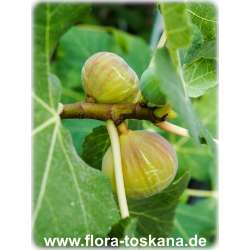Ficus carica 'Paradiso' - Fig
The well-known fig variety 'Paradiso' with green skin and dark flesh is a relatively early-ripening variety (usually at the end of August in good conditions) with a phenomenal taste.
![]() General information on fig trees:
General information on fig trees:
Fig trees have much more to offer than their known, sugar-sweet, drop-shaped fruit, which taste so much better eaten straight off the tree than dried. The huge, hand-shaped leaves are highly decorative. In summer, the sun elicits a tangy, sweet aroma from them that immediately brings to mind Mediterranean landscapes and the last vacation at the Mediterranean Sea. Even in our climate the fruits ripen easily – already when the plants are only 2 years old. Modern varieties no longer depend on the complicated pollination by fig wasps! They develop seedless fruit without fertilisation. A rich harvest is guaranteed every year, especially since fig trees are extremely robust and hardy plants that can be planted in the garden. Even with continuous frost figs have no problems – not only the much described and advertised "frost hardy" varieties! The roots of all fig trees survive any hard winter and produce new growth in spring. Extreme cold of about -15°C, however, will freeze any unprotected tree top. Winter hardiness can be improved by several degrees by covering the plant with fleece, bamboo mats or any other protective material permeable to light and air. Fig trees in pots should be kept indoors from October/November; occasional frost is no problem. Garages, garden sheds and tool sheds can be used for this purpose, as well as cool basement rooms, stairs, unheated conservatories and many other premises (warehouses, barns, etc.). Fig trees generally drop their leaves in fall so that they need only little light during winter. Permanently heated rooms like living rooms or winter gardens are unsuitable for wintering fig trees. In that case the trees would grow unnaturally long shoots and giant leaves and fruit poorly. Over the years they would use up their energy because they do not have winter rest. A cool place in winter is best in any case.![]() Quality: even young plants produce tasty fruits; no pollination necessary for fruits; reliably rich harvest every year; attractive plants with hand-shaped and aromatic leaves; easy to overwinter
Quality: even young plants produce tasty fruits; no pollination necessary for fruits; reliably rich harvest every year; attractive plants with hand-shaped and aromatic leaves; easy to overwinter![]() Use:from April in containers on balcony & terrace or in the garden; planted out in the garden; year round in an unheated conservatory
Use:from April in containers on balcony & terrace or in the garden; planted out in the garden; year round in an unheated conservatory
Data sheet
- Family
- Moraceae
- Origin
- Mediterranean
- Fruits
- Edible fruits
- Growth
- Tree
- Location
- Sunny
- winter temperature
- 5 (+/- 5) °C
- Minimum temperature
- -15 °C
- Hardiness Zones
- 7
- Height
- 3 - 4 m
You might also like
Customers who bought this product also bought:




























